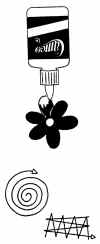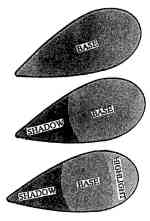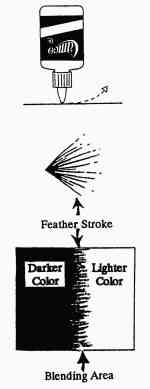It only takes a few minutes to learn the following Outline, Fill-In, and Blending techniques to begin painting. Remember to paint in small sections no larger than 1 square inch which allows you to Outline, Fill-In, and Blend the paint while it is still wet.
Outline
The first step in painting is to Outline using the following technique:
Hold The Bottle Upright and VerticalPlace the tip just inside the design line, not over the line. As you paint, the width of the paint from the tip will cover the line. If you place the tip over the line, the paint will overlap outside the line. Position the design so that it is always possible to see the part you are painting. Paint toward you, or right to left if you are right handed, so that you can see the part of the design you are painting. Outline as if you are tracing the lines of the design. It is not necessary to go back and forth to get a solid outline of the design you are painting. All you have to do is keep the bottle vertical and squeeze the bottle while moving the tip just inside the design line with light (not excessive) pressure. Avoid irregular strokes which will result in a ragged appearance. |
 |
Fill-InFill-In the parts of the design Outlined using circular strokes or criss-crossing strokes to ensure the paint properly penetrates the fabric. Painting in only one direction will result in uneven paint coverage and poor paint penetration of the fabric. Proper paint penetration is required to ensure the paint colors remain vivid and permanent after washing or dry cleaning. |
 |
Blend
Blending is a technique which uses Cameo's Blending Tool (C369) to smooth and work the paint into the fabric immediately after Filling-In. It only takes a few seconds to use the rounded part of the Blending Tool tip to blend the paint into the fabric while the paint is still wet.
The ease in blending colors is one of the major features of Cameo painting. Even first time painters can create artist quality color tones with the following Blending techniques. For smooth blending, paint in small areas and immediately blend while the paint is still wet.
Base Color Blending
Base Color Blending is used to add a highlight or shadow color to a base color using the following techniques.
| 1. |
Paint Base ColorPaint Base Color using Outline and Fill-In techniques described above. |
 |
| 2. |
Add Shadow ColorPaint shadow color (darker color than base color) over the base color. Use the Blending Tool to blend the shadow color into the base color. |
|
| 3. |
Add Highlight ColorPaint highlight color (lighter color than base color) over the base color. Use the blending tool to blend the highlight color into the base color. |
Two Color Blending and Feather Stroking
Two Color Blending is the blending of two complementary colors. The darker color is blended into the lighter color using the following techniques.
| 1. | In the area where two colors blend together, use the feather stroke as explained below:
|
 |
| 2. | First paint lighter color. Use feather stroke in "Blending Area". | |
| 3. | Paint darker color. Use feather stroke in "Blending Area" to blend darker color into lighter color. | |
| 4. | Use Blending Tool to smoothly blend darker color into lighter color in "Blending Area". |
